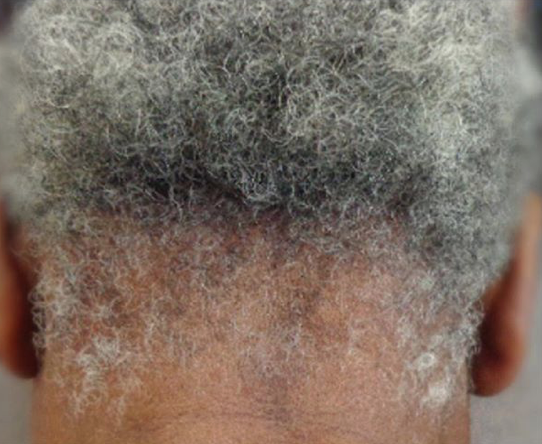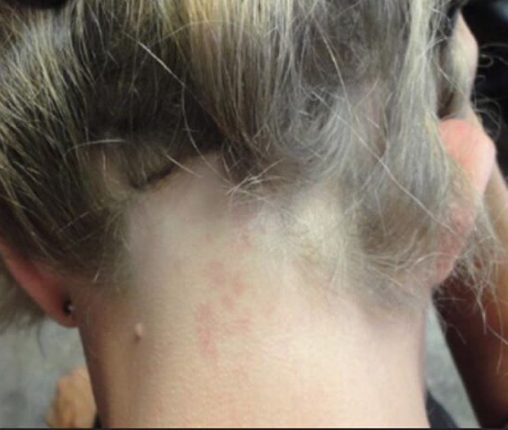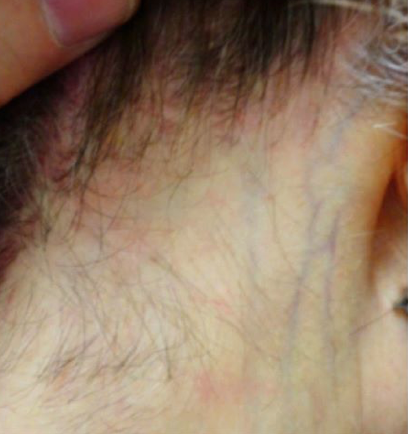Hair Loss at the Nape of the Neck: What are the main causes?
Losing Hair at the Nape: What are the main Causes?
Hair loss can either be localized (meaning one area of the scalp) or diffuse (meaning all over the scalp). There are many causes of hair loss at nape of the neck and the back of the scalp.
1. Traction alopecia (photo 1)
Traction alopecia refers to a type of hair loss due to the tight pulling of hair. The back of the scalp is particularly susceptible to loss of hair. Hair styling practices can frequently lead to traction including braids and weaves and pony tail. If traction alopecia is of recent onset, hair regrowth can occur even without treatment. If traction is longer standing, the hair loss can often be permanent. Some women with hair loss that looks like traction actually have a scarring alopecia known as cicatricial marginal alopecia.
PHOTO 1: Traction alopecia presenting as hair loss in the nape
2. Alopecia Areata (photo 2)
Alopecia areata is an autoimmune disease that affects about 2 % of the world. Hair loss can occur anywhere. Alopecia areata can frequently cause hair loss specifically at the nape in some patients. The particular form that causes loss at a the back of the scalp is the 'ophiasis' form. The ophiasis form is frequently resistant to standard treatments although topical steroids, steroid injections and diphencyprone are typically first line.
PHOTO 2: Alopecia areata presenting as hair loss in the nape
3. Androgenetic Alopecia (photo 3)
Androgenetic alopecia (male and female thinning) typically causes hair loss at the top of the scalp. In men, the temples and crown are most often affected. In women, the mid-scalp region is generally affect first. The back of the scalp can also be affected although this is not typically thought of. Hair thinking along the nape is not uncommon in advancing balding in men and women.
PHOTO 3: Androgenetic alopecia (AGA) presenting as thinning in the nape
4. Frontal Fibrosing Alopecia (photo 4)
Frontal fibrosing alopecia (FFA) is a type of scarring alopecia. FFA typically affects women between 45-70. Most often hair is lost along the frontal hairline and eyebrow. However the back of the scalp (at the nape) and frequently be affected. The hair loss in the nape typically starts at the sides (left side and right side) just behind the ears. Treatments for FFA include topical steroids steroid injections, topical calcineurin inhibitors. Oral drugs include finasteride, doxycycline and hydroxychloroquine at the top of the list.
PHOTO 4: Frontal fibrosing alopecia (FFA) presenting as hair loss in the nape
5. Heat and Chemicals
Heat and chemical treatments can lead to hair shaft damage and hair loss at the nape. Frequently, heat and chemical overuse leads to an increased tendency to develop traction alopecia which si discussed above.
6. Acne keloidalis nuchae
Acne keloidalis nuchae (AKN) is a condition that can affect both men and women. Small papule or bumps develop along the posterior scalp and are accompanied by hair loss in the region as well. The hair loss in AKN is often permanent and can lead to thicken and thicker scars some of which are disfiguring.
7. Hair shaft disorders
Some individuals are born with abnormalities in how the hair shaft is produced. This frequently leads to hair breakage. Monilethrix is one of the hair shaft disorders that frequently leads to hair loss along the nape.
This article was written by Dr. Jeff Donovan, a Canadian and US board certified dermatologist specializing exclusively in hair loss.




